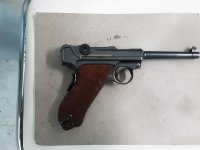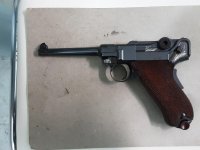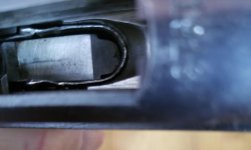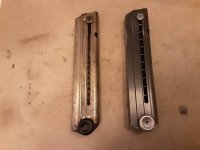;e.g-the last time I put it back together I had to use a screwdriver (wrapped in cloth) to get the take-down lever to go down. ...
Breaking it down to a point where you would need a punch tool to remove the smaller pins, all the parts look good, as if it was cleaned properly within the last few decades. ...
Always have the bbl and toggle assembly pushed all the way to the rear when pulling the TD lever down or try to push it back into position on re-assembly.
Additionally on re-assembly make sure the side plate is installed correctly and is sitting all the way down. If it's not, it's usually the front leg that is up high just a little and the TD can't be pushed easily back into position.
Unless there is a real need to disassemble parts further than the Field disassembly of the breech, toggle and frame, it's not generally worth the effort.
If they are damaged or worn and need attention that's different, then the disassembly is needed.
Plus there are a couple parts that can be damaged trying to remove and/or replace if you're not familiar with them.
Most are straight forward gunsmith removal/install types though.
Have fun,,very unique gun the Luger is.
FWIW, you don't have to dry fire them to let/relax the firing pin down.
With the unloaded pistol cocked, magazine removed,,let the toggle down slowly keeping a grasp on the toggles.
As the breech closes, at a point approx where the breech block is about 1/8" from being closed you'll feel a slight hang up in the forward motion.
That is the firing pin being engaged by the sear and being cocked.
To bypass that cocking action simply hold the trigger back as the breech block passes that point.
The firing pin will not be cocked.
The breech will close and the firing pin will be down & uncocked.
(It's not a good idea to dry fire a Luger anyway. The firing pin tip is rather fragile in the design. I don't recommend dry fire on any firearm.
On a pistol like a Luger, if you must to check function for instance,,a flat faced hardwood dowel held firmly down the bore against the breech face buffers the firing pin quite well)





